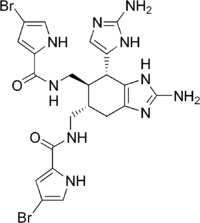Ageliferin
 | |
| Names | |
|---|---|
| IUPAC name
N-[[(5S,6R,7R)-2-Amino-7-(2-amino-1H-imidazol-5-yl)-5-[[[(4-bromo-1H-pyrrol-2-yl)carbonyl]amino]methyl]-4,5,6,7-tetrahydro-1H-benzimidazol-6-yl]methyl]-4-bromo-1H-pyrrole-2-carboxamide | |
| Other names
Ageliferine | |
| Identifiers | |
| 117417-64-8 | |
| 3D model (Jmol) | Interactive image |
| ChEMBL | ChEMBL502866 |
| ChemSpider | 9344613 |
| PubChem | 11169518 |
| |
| |
| Properties | |
| C22H24Br2N10O2 | |
| Molar mass | 620.31 g·mol−1 |
| Except where otherwise noted, data are given for materials in their standard state (at 25 °C [77 °F], 100 kPa). | |
| | |
| Infobox references | |
Ageliferin is a chemical compound produced by some sponges. It was first isolated from Caribbean and then Okinawan marine sponges in the genus Agelas.[1][2][3] It often co-exists with the related compound sceptrin and other similar compounds. It has antibacterial properties and can cause biofilms to dissolve.[4]
See also
References
- ↑ Rinehart, Kenneth L; et al. (1990). "Bioactive Compounds from Aquatic and Terrestrial Sources". Journal of Natural Products. 53 (4): 771–792. doi:10.1021/np50070a001.
- ↑ Keifer, Paul A.; et al. (1991). "Bioactive Bromopyrrole Metabolites from the Caribbean Sponge Agelas conifera". J. Org. Chem. 56 (9): 2965–75. doi:10.1021/jo00009a008.
- ↑ Kobayashi, Junichi; et al. (1990). "Ageliferins, potent actomyosin ATPase activators from the Okinawan marine sponge Agelas sp.". Tetrahedron. 46 (16): 5579–86. doi:10.1016/S0040-4020(01)87756-5.
- ↑ Laura Sanders (2009). "Sponge's secret weapon restores antibiotics' power: Bacteria treated with compound lose their resistance". Science News. 175 (6): 16. doi:10.1002/scin.2009.5591750616.
This article is issued from Wikipedia - version of the 10/5/2015. The text is available under the Creative Commons Attribution/Share Alike but additional terms may apply for the media files.